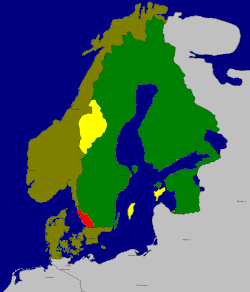
The Treaty of Brömsebro in 1645. Brown: Denmark-Norway; Green: Sweden; Yellow: the provinces of Jämtland, Härjedalen, Idre & Särna and the Baltic Sea islands of Gotland and Ösel, which were ceded to Sweden; Red: the province of Halland, ceded for 30 years
The Second Treaty of Brömsebro (or the Peace of Brömsebro) was signed on 13 August 1645, and ended the Torstenson War, a local conflict that began in 1643 and was part of the larger Thirty Years' War) between Sweden and Denmark-Norway. Negotiations for the treaty began in February the same year.
Location
The eastern border between the then Danish province of Blekinge and the Swedish province of Småland was formed by the creek Brömsebäck. In this creek lies an islet that was connected to the Danish and Swedish riversides by bridges. On the islet was a stone that was supposed to mark the exact border between the two countries. By this stone, the delegates met to exchange greetings and, at the end of the negotiations, the signed documents.[1] The Danish delegation stayed in Kristianopel while the Swedish side had their accommodation in Söderåkra.[2]
Delegations
Sweden's highest ranking representative was Lord High Chancellor Axel Oxenstierna. He was accompanied by, among others, Johan Skytte, who died during the negotiations and was replaced by Ture Sparre.[2]
Corfitz Ulfeldt and Chancellor Christen Sehested were the chief negotiators of the Danish delegation.[2]
The French diplomat Gaspard Coignet de la Thuillerie was head mediator and observers from the Hanseatic League, Portugal, Stralsund and Mecklenburg followed the negotiations.[2]
Results
The military strength of Sweden ultimately forced Denmark-Norway to give in to Swedish demands.
- Denmark-Norway ceded the Norwegian provinces of Jämtland, Härjedalen and Idre & Särna as well as the Danish Baltic Sea islands of Gotland and Ösel.
- The Danish heir to the throne, Frederick II Administrator of the Prince-Bishopric of Verden (1634-1645) and of the Prince-Archbishopric of Bremen (1635-1645), had to resign, with the two prince-bishoprics being occupied by the Swedes.
- Sweden was exempted from the Sound Dues, a toll on foreign ships passing through Danish waters into the Baltic Sea, and Hamburg was exempted from the “Elbe dues”, a toll levied until then on ships to that city by the Prince-Archbishopric of Bremen.
- Sweden received the Danish province of Halland for a period of 30 years as a guarantee of these provisions.
The treaty was to be followed by the Treaty of Roskilde of 1658, which forced Denmark-Norway to further concessions.
See also
- dominium maris baltici
- First Treaty of Brömsebro (1541)
- List of Swedish wars
- List of Danish wars
- List of treaties
Notes
- ↑ Englund, Peter (2003) (in Swedish). Ofredsår. Stockholm: Atlantis. pp. 368 and 394. ISBN 91-7486-349-5.
- ↑ 2.0 2.1 2.2 2.3 Eriksson, Bo (2007) (in Swedish). Lützen 1632. Stockholm: Norstedts Pocket. pp. 32–33. ISBN 978-91-7263-790-0.
References
- History of the Norwegian People by Knut Gjerset, The MacMillan Company, 1915, Volume I.
- Nordens Historie, ved Hiels Bache, Forslagsbureauet i Kjøbenhavn, 1884.
- The Struggle for Supremacy in the Baltic: 1600-1725 by Jill Lisk; Funk & Wagnalls, New York, 1967.
The original article can be found at Second Treaty of Brömsebro (1645) and the edit history here.